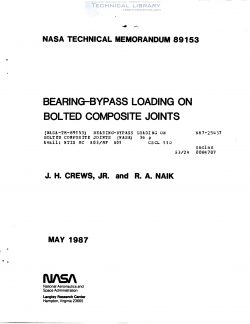NASA-TM-89153
- Version
- 302 Downloads
- 6.91 MB File Size
- 1 File Count
- August 19, 2017 Create Date
- August 19, 2017 Last Updated
Bearing Bypass Loading on Bolted Composite Joints

A combined experimental and analytical study has been conducted to
investigate the effects of simultaneous bearing and bypass loading on a
graphite/epoxy (T300/5208) laminate. Tests were conducted with a test machine
that allows the bearing-bypass load ratio to be controlled while a single-
fastener coupon is loaded to failure in either tension or compression. Test
coupons consisted of 16-p1y quasi-isotropic graphite/epoxy laminates with a
centrally- located 6.35-mm bolt having a clearance fit. Onset-damage and
ultimate strengths were determined for each test case. Next, a finite element
stress analysis was conducted for each test case. The computed local stresses
were used with appropriate failure criteria to analyze the observed failure
modes and strengths. An unexpected interaction of the effect of the bypass and
bearing loads was found for the onset of compression-reacted bearing damage.
This interaction was caused by a decrease in the bolt-hole contact are and a
corresponding increase in the severity of the bearing loads. The amount of
bolt-hole contact had a significant effect on local stresses and, thus, on the
calculated damage-onset and ultimate strengths. An offset-compression failure
mode was identified for laminate failure under compression bearing-bypass
loading. This failure mode appears to be unique to compression bearing-bypass
loading and, therefore, cannot be predicted from simple tests.
In the past, composite joints have often been designed using rather
simple metals-based procedures without encountering serious problems. In most
such cases, the structural design strains have been limited by damage-tolerance
considerations, and at low structural strain levels, the joints have been
adequate. However, as tougher composites come into use, the design strains will
rise and structural joining requirements will become more critical. Analytical
design procedures for joints should be based on a sound understanding of the
response of composite materials under loading conditions similar to those in
multi-fastener joints.
| File | Action |
|---|---|
| NASA-TM-89153 Bearing Bypass Loading on Bolted Composite Joints.pdf | Download |
Comment On This Post